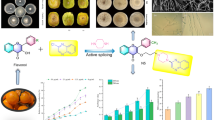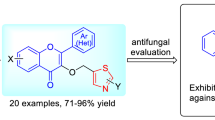Abstract
A new flavonoid and two known flavonoids were isolated from the EtOAc extract of the leaves of Astragalus membranaceus (Fisch) Bge. var. mongholicus (Bge) Hsiao (A. membranaceus). This is the first report on the structure elucidation of the new compound based on spectroscopic methods including UV, IR, ESI-MS, 1D NMR, and 2D NMR techniques. The isolated compounds exhibited antifungal activity against different Fusarium oxysporum f.sp. dianthi pathotypes.
Graphical abstract

Similar content being viewed by others
Avoid common mistakes on your manuscript.
Introduction
Astragalus membranaceus is a member of the family Ranunculaceae, genus Paeonia and distributed throughout Inner Mongolia, Shanxi, Xinjiang of China. The roots of A. membranaceus are the most important tonic traditional Chinese medicine, and promote the discharge of pus and the growth of new tissue [1]. Polysaccharides [2], saponins [3–5], and flavonoids [6–12] have been isolated from the roots of A. membranaceus.
However, flavonoids are a class of secondary metabolites generally located in plant leaves as water-soluble glycosides in the vacuoles of epidermal cells [13]. These compounds are not only present in plants as constitutive agents but are also accumulated in plant tissues in response to microbial attack [14, 15]. The secondary metabolites often differ in different organs of the same plant. For aiming to discover structurally unique and bioactive compounds, a new flavonoid with two known flavonoids was isolated from the leaves of A. membranaceus.
The flavonoids have been subjected to antifungal tests on different Fod pathotypes to evaluate the possible involvement of A. membranaceus flavonoids in resistance to pathogen attack.
Results and discussion
Structure elucidation
The 95 % ethanol extract of A. membranaceus was suspended in water, and then partitioned with petroleum ether, CHCl3, EtOAc, and n-BuOH. The EtOAc-soluble fraction was separated by chromatography and afforded a new flavonoid with two known flavonoids which are isolated from this plant for the first time (Fig. 1). The structures of the known compounds were identified by comparing their spectroscopic data with those reported in the literature [16, 17].
Compound 1 was obtained as a yellow powder. The positive reactions to the Molish and HCl–Mg tests suggested that the compound was a flavonoid glycoside. The molecular formula was determined to be C43H48O22 by HR-ESIMS at m/z = 915.2550 [M–H]−. The 1H NMR spectrum of 1 (Table 1) showed two olefinic hydrogens at δ = 7.66 ppm (1H, d, J = 16.0 Hz) and 6.37 ppm (1H, d, J = 16.0 Hz), which suggested the presence of a trans-olefinic group in compound 1. Furthermore, the signals of nine aromatic protons at 7.64 ppm (1H, dd, J = 8.0, 1.5 Hz), 6.98 ppm (1H, d, J = 8.0 Hz), 8.10 ppm (1H, d, J = 1.5 Hz), 6.19 ppm (1H, d, J = 1.5 Hz), and 6.41 ppm (1H, d, J = 1.5 Hz) indicated the presence of an ABC system for B ring and an AB system for A ring of a flavone. The remaining aromatic signals at 7.53 ppm (2H, d, J = 8.0 Hz) and 6.88 ppm (2H, d, J = 8.0 Hz) were assigned to a benzene ring of coumaroyl acid.
A detailed analysis of the 13C NMR spectral data (Table 1) and correlations observed by HSQC, HMBC, DEPT, and 1H–1H COSY experiments provided evidence for a flavone and a benzoic acid unit including an isorhamnetin unit confirmed the HMBC correlations (Fig. 2) from 7.43 ppm (H-6′) to C-2 (157.2 ppm), C-2′ (113.2 ppm) and C-4′ (149.4 ppm), and 8.01 ppm (H-2′) to C-2 (157.2 ppm), C-6′ (122.3 ppm) and C-4′ (149.4 ppm), and 6.98 ppm (H-5′) to C-3′ (146.9 ppm) and C-1′ (121.1 ppm), and 6.19 ppm (H-6) to C-8 (93.4 ppm) and C-10 (104.5 ppm), and 6.41 ppm (H-8) to C-6 (98.4 ppm) and C-10 (104.5 ppm), 4.06 ppm (OCH3) to C-3′ (146.9 ppm); a coumaroyl acid unit confirmed the HMBC correlations from 7.53 ppm (H-2‴,6‴) to C-4‴ (160.0 ppm) and C-7″ (146.2 ppm), and 6.88 ppm (H-3‴,5‴) to C-1‴ (125.7 ppm) and C-4‴ (160.0 ppm).
The 13C NMR spectrum of 1 (Table 1) also showed the presence of 18 carbon signals except for the aglycone carbons. The presence of a d-galactopyranose (99.4, 72.4, 76.8, 70.7, 72.5, and 65.4 ppm) was confirmed via sugar analysis [18]. The anomeric proton appearing at 5.83 ppm (1H, d, J = 7.5 Hz) and their corresponding carbons resonating at 99.4 ppm (C-1″) from the HSQC experiment also suggested the presence of a β-d-galactopyranose. The remaining signals at 101.6, 70.9, 70.8, 72.5, 68.6, and 16.2 ppm, and 100.8, 70.7, 70.6, 72.3, 68.5, and 16.6 ppm belong to two l-fucopyranoses, which was confirmed by comparing their spectral data with those reported in the literature [19].
The HMBC correlations from H-1″ (5.83 ppm) to C-3 (132.9 ppm), and H-4″ (5.41 ppm) to C-9‴ (167.3 ppm) indicated that the β-d-galactopyranose and a coumaroyl acyl were attached to C-3 and C-4″, respectively. In addition, the HMBC correlations of H-1′′′′ (5.18 ppm) to C-3″ and H-1′′′′′ (4.52 ppm) to C-6″ confirmed that the two l-fucopyranoses were linked at C-3″ and C-6″, respectively. The anomeric configuration in the l-fucopyranoses was determined as α according to the singlet peak. Thus, the structure of compound 1 was elucidated as isorhamnetin-3-O-(4-O-[E]-coumaroyl-3,6-α-l-O-fuco-pyranosyl)-β-d-galactopyranoside.
Biological assays
The isolated flavonoids 1–3 and a commercial sample of rutin have been tested to evaluate their ability to act as fungitoxic agents towards three main races of Fod affecting A. membranaceus, pathotypes 2, 4, and 8 [20, 21]. The biological tests (Table 2) showed that flavonoids 1–3 exhibited appreciable inhibition of mycelial growth with variable activities depending on Fod race. In particular, lowest inhibition percentages were observed on race 2, where flavonoid 3 was the most effective treatment (36 %). Flavonoids 1–3 and rutin exhibited a good activity towards Fod race 4 with an average value of growth inhibition approximately 54 % at the highest dose used (Table 2). Pathotype 8 was inhibited mostly by flavonoids 1–3, though Rutin was scarcely or not effective on races 2 and 8. Flavonoids are abundant widespread in many other plants. Although the mechanism of action of such compounds against fungi is still unknown, their efficacy, availability at low cost, and low toxicity to humans give the flavonoids potential as natural fungicides.
Conclusions
A new flavonoid and two known flavonoids were isolated from the EtOAc extract of the leaves of A. membranaceus. Flavonoids 1–3 exhibited appreciable inhibition of mycelial growth with variable activities depending on Fod race.
Experimental
The HR-ESI-MS spectra were measured on Bruker Daltonics Micro TOFQ (Bruker, Germany). NMR spectra were measured on a Bruker AV-500 spectrometer (Bruker, Germany) with tetramethylsilane (TMS) as the internal reference, and chemical shifts are expressed in δ (ppm). Semi-preparative HPLC (Shimadzu, Japan) was performed using a Japanese liquid chromatograph equipped with a EZ0566 column. The UV spectra were recorded on a Shimadzu UV-2201 spectrometer (Shimadzu, Japan). The IR spectra were recorded in KBr discs on a Thermo Nicolet 200 double-beam spectrophotometer (Shimadzu, Japan). Column chromatography was performed using silica gel (200–300 mesh, Marine Chemical Factory, Qingdao, China) and Sephadex LH-20 (Pharmacia, Uppsala, Sweden). Fractions were monitored by TLC (silica gel GF254 10–40 μm, Marine Chemical Factory, Qingdao, China), and spots were visualized by heating silica gel plates sprayed with 10 % H2SO4 in EtOH.
Plant material
The leaves of A. membranaceus were collected in Xinganling, Inner Mongolia of China, in August 2013, and identified by Prof. Buhebateer (Inner Mongolia University for Nationalities). A voucher (No. 20130628) has been deposited in the School of Traditional Mongolian Medicine of Inner Mongolia University for Nationalities.
Extraction and isolation
The leaves of A. membranaceus (3.0 kg) were powdered and extracted twice under reflux with 30 dm3 95 % EtOH. Evaporation of the solvent under reduced pressure delivered the 95 % EtOH extract. The extract was partitioned with petroleum ether (P.E.), CHCl3, EtOAc, and n-BuOH. The EtOAc-soluble fraction (28.0 g) was isolated by column chromatography on silica gel and gradiently eluted with CHCl3-CH3OH (60:1–10:1) to give five fractions (fractions 1–5). Fraction 4 (200 mg) was further chromatographed on Sephadex LH-20 column eluting with MeOH, and then separated by semi-preparative HPLC (CH3OH–H2O, 39:61) yielding 1 (28 mg), 2 (32 mg), and 3 (40 mg).
Biological assays
Fungitoxic activity of flavonoids 1–3 and commercial rutin (Sigma-Aldrich, MO) was evaluated by means of the poisoned medium technique [22]. Three different pathotypes of Fod, obtained by by Prof. Burie (Inner Mongolia University for Nationalities, China), were employed in this trial: Fod race 2 (isolate 2–75), Fod race 4 (isolate 1.06.04), and Fod race 8 (276). Weighted amounts of each tested compound were aseptically added, after dissolution in 200 cm3 of sterile H2O and ultra-filtration (0.1 mm), to flasks containing 20 cm3 of sterilized potato dextrose agar (PDA), when still molten, to reach the final concentrations of 700, 350, and 35 mM. The medium was then poured into 35 mm i.d. Falcon culture dishes and allowed to solidify. A mycelial disc (2 mm i.d.) taken from 7-day-old culture was inoculated to each Petri dish. Plates containing non-poisoned medium served as control. Mycelial diameters, in control as well as in treatment sets, were recorded after incubation for 72 h at 26 °C. The data obtained on mycelial growth were pooled from four replicates and subjected to one-way ANOVA, after arcsine transformation. Treatments means were compared using critical difference at P = 0.05; similarity groups were determined using the Student–Newman–Keuls post hoc test.
References
State PC (2010) Chinese Pharmacopoeia. China Medical Pharmaceutical Science and Technology Publishing House, Beijing
Huang QS, Lu GB, Li YC, Guo JH, Wang RX (1982) Acta Pharm Sin 17:200
Bian YY, Guan J, Bi ZM, Song Y, Li P (2006) Chin Pharm J 41:1217
Luo Z, Su MZ, Yan M, Shi GB, Zhao QC (2012) Chin Trad Herb Drug 43:458
Wen YH, Cheng L, Zheng D, Huang XS, Han L (2010) Prac Pharm Clin Rem 13:115
Zhao M, Duan JA, Huang WZ, Zhou RH, Che ZT (2002) J Chin Pharm Univ 33:274
Sun J, Zhang L, Zhang XL, Yan RQ, Chai X, Wang YF (2013) Drugs Clin 28:138
Bi ZM, Yu QT, Li P, Lin Y, Gao XD (2007) Chin J Nat Med 15:263
Li RF, Zhou YZ, Qiao L, Fu HW, Fei YH (2007) J Shen Pharm Univ 24:20
Wang JL, Xu HM, Li WH, Hua Z, Zhang SJ (2008) Chin J Chin Mat Me 33:414
Wang QH, Wang XL, Ao WLJ, Dai NYT, Han NRCKT (2014) Chin Pharm J 49:357
Wang QH, Han NRCKT, Dai NYT, Wang XL, Ao WLJ (2014) J Mol Struc 1076:535
Harborne JB, Williams CA (2000) Phytochemistry 55:481
Harborne JB (1999) Bioc Sys Ecol 27:335
Grayer RJ, Harborne JB (1994) Phytochemistry 37:19
Julião LDS, Leitão SG, Lotti C (2010) Phytochemistry 7:1294
Albacha DC, Grayerb RJ, Jensen SR (2003) Phytochemistry 64:1295
Tanaka T, Nakashima T, Ueda T, Tom K, Kouno I (2007) Chem Pharm Bull 55:899
Gorin PAJ, Mazurek M (1975) Can J Chem 53:1212
Scala A, Tegli S, Poggioli V, Lagazio C (1998) Phytoparasitica 26:213
Blanc H (1983) Acta Horticulturae 141:43
Grover RK, Moore JD (1962) Phytochemistry 52:876
Acknowledgments
We thank the financial support from the scientific research project of the Inner Mongolia Autonomous Region colleges in China (NJZZ14182) and the National Natural Science Foundation of China (No. 81460654). The authors are grateful to Ning Xu and Narenchaoketu for the measurements of NMR spectra.
Author information
Authors and Affiliations
Corresponding author
Electronic supplementary material
Below is the link to the electronic supplementary material.
Rights and permissions
About this article
Cite this article
Wang, Q., Wu, R., Wu, X. et al. Three flavonoids from the leaves of Astragalus membranaceus and their antifungal activity. Monatsh Chem 146, 1771–1775 (2015). https://doi.org/10.1007/s00706-015-1473-0
Received:
Accepted:
Published:
Issue Date:
DOI: https://doi.org/10.1007/s00706-015-1473-0






